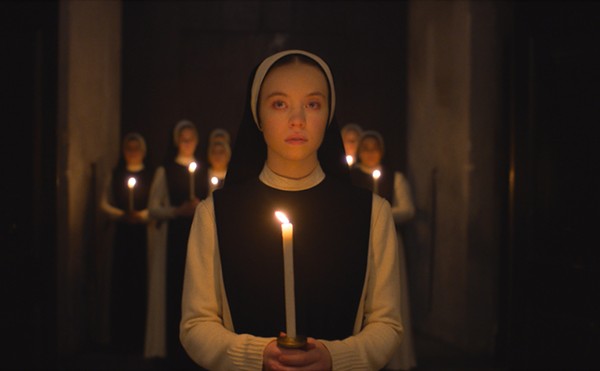Born into a musical family in Birmingham, Alabama, in 1914 (he still speaks with a genteel Southern drawl), Hugh Martin started to play the piano at age five. Although his mother hoped he'd become a concert pianist, after hearing George Gershwin's "Rhapsody in Blue" and Jerome Kern's Show Boat, "I fell in love with jazz and theater music," Martin says by phone from his home in Encinitas, California.
By age nineteen he'd moved to New York. Former St. Louisan Kay Thompson (best remembered as the creator of the plucky young illustrated character Eloise) rescued Martin from a job as a saloon piano player and hired him as her popular radio show's rehearsal pianist. "Being around Kay was like taking a crash course in music," Martin recalls.
Richard Rodgers was another early teacher. They met after Martin wrote the celebrated composer to ask why theater vocal arrangements weren't more hip. Intrigued, Rodgers offered 24-year-old Martin a job as vocal arranger for the new Rodgers and Hart musical, The Boys from Syracuse. Thanks to Martin's swing arrangements, jazz found its way to Broadway. "I felt that Broadway needed a little injection of what everybody else was doing. In the late 1930s the movies were doing jazz, records were doing jazz. But theater music was still a little square," Martin says.
A grateful Rodgers promptly hired Martin again -- and again. "Until I worked with Dick Rodgers, I had no self-esteem," Martin says. "But he believed in me. He could be very critical, but always in a supportive, constructive kind of way. Dick and I worked so closely together, he became like a second father. I really felt like a showbiz son to him."
In 1941 Broadway's most successful director, George Abbott, took on a secret partner -- Richard Rodgers -- to produce a new musical about young people. They wanted the score to be composed by young talent. Rodgers recommended Martin and his writing partner Ralph Blane -- who as a team had yet to write a single song. "I wouldn't have had any career without Best Foot Forward," Martin says. "It was a fluky, marvelous miracle" -- and it ran nearly a year.
At which point, a second St. Louis woman entered Martin's life. In 1941 and early '42, magazine readers were charmed by a series of short stories by Sally Smith Benson in The New Yorker. Titled "5135 Kensington Avenue," they were named for the address two blocks west of Kingshighway where the Benson family lived until 1910, when Mr. Smith was transferred to New York. Benson moved the time frame back six years so they could climax at the opening of the 1904 World's Fair -- with the fictional family triumphantly remaining in town.
After the stories were published in book form under the new title Meet Me in St. Louis, MGM bought the book for Arthur Freed, who ran the studio's musical unit. Freed in turn hired Martin and Blane, who were in Hollywood for Freed's filming of Best Foot Forward, to write a few new tunes to complement such period ditties as the 1904 title song.
From the moment they began to compose Best Foot Forward, Martin and Blane always shared their writing credits. "Best Foot Forward was 50-50; Ralph would write one song and I'd write the next," Martin says. "But after we got to California, even though we continued to share the credit, I did about 90 percent of the work. Ralph got a little bit careless, a little bit lazy, a little bit too fond of the Hollywood lifestyle. So I wrote all the songs in Meet Me in St. Louis, although he did give me some wonderful advice. On 'The Boy Next Door,' for instance, it was Ralph's idea to use the Kensington Avenue addresses of the lovers. So I put that in at the end of the verse, and it really makes the song."
For "The Trolley Song" Blane found a Beverly Hills library book with a photo of a turn-of-the-century trolley. The caption -- "Clang, clang, clang, went the trolley" -- was all the inspiration Martin needed. Even before the movie's November 1944 release, "The Trolley Song" had sold more than 500,000 copies.
Although "The Trolley Song" was the immediate runaway best seller, Martin's third tune, "Have Yourself a Merry Little Christmas," has been the most enduring. Today it is one of the ten most-recorded songs of all time, with more than 500 separate renditions. (Martin's favorite? Mel Tormé.)
Yet despite his formidable contributions, Martin was little appreciated while the film was being made: "Arthur Freed ignored me. [Director Vincente] Minnelli ignored me. I never even got to work with Judy on the vocal arrangements. I was used to the kind of respect I received from Dick Rodgers, so the Hollywood treatment made me furious. I'm ashamed to admit it now, but I was so mad at all of them that I refused to go on the set. Now I wish I had. I wish I'd seen that trolley."
By this point, World War II was entering its final bloody year. Prior to the film's release, Martin enlisted and was shipped to Europe: "When my officers learned that I had written 'The Trolley Song,' they transferred me to an army show to sing it. Then my original unit sustained heavy losses in the Battle of the Bulge. Surely that song saved my life."
After the war, geography separated the songwriting team. Blane remained in Hollywood; Martin returned to New York. In 1951 he read that Judy Garland (by now a good friend) was about to make her vaudeville debut at New York's famed Palace Theater. Martin phoned her and asked if he could purchase a pair of house seats.
Garland stunned him by inviting him to join her on stage. The triumphant three-week engagement was extended to nineteen weeks. "That was zenith time," Martin recalls. "That was the high spot of my life."
Although Garland had always concluded her concerts with "Over the Rainbow," it was Martin's inspiration to have her perform that signature song without amplification: "During rehearsal, sitting in the balcony for a sound check, I heard Judy sing 'Over the Rainbow' without a microphone. It carried beautifully over the orchestra. So I went to her and said, 'You're going to think I'm crazy, but why not let the audience hear your sweet, natural voice?' For the rest of her career, she always sang it that way."
Three years later Garland asked Martin to score her vocal arrangements for the now-classic movie musical A Star is Born, but this time she was not so accepting of his advice.
"She was abusive to me because she was on drugs," Martin says. "For 'The Man That Got Away,' I wrote that little trombone duet that opens and closes the song. But we fought over her delivery. I wanted her to sing it very simply, in her MGM voice, not in her loud, brassy vaudeville voice. She got angry and said, 'I don't sing like that anymore. That was a child's voice; I'm a woman now.'
"And I said, 'Well, honey, I think you've always had a woman's voice.'
"Then [director George] Cukor came to me and said, 'Can't you do anything about Judy screaming that song and waving her arms around? I want it to be as if she's singing among friends after hours in a Sunset Boulevard nightclub.'
"I said, 'That's what I want too. Please go tell her that, Mr. Cukor. She won't listen to me but she'll listen to you.'
"And he said, 'She will listen to no one.'
"So that's when I left the picture, though we did make up afterwards. We loved each other too much not to make up. We were meant for each other musically."
Even before the movie finished filming, Sally Benson approached Martin about adapting Meet Me in St. Louis to the stage. But it wasn't until the Muny commissioned a production in 1960 that the transformation occurred. Martin wrote several new songs and came to St. Louis to rehearse the singing chorus. Though he's returned for nearly every revival since, he will not be here this summer.
"I no longer travel too well," he explains. "My health is good, and I'm fine and happy. But at age 89 there are old-man complications. At home I do better."
As an old man of the theater, Martin's mind is a veritable world's fair of memories, many of which are associated with his triad of St. Louis hits -- and of the two St. Louis women who so influenced his life. "Back in the 1930s when I was Kay Thompson's rehearsal pianist," he recalls, "I used to say, 'Kay, I'm writing some little songs. I wonder if anyone will ever hear them.' I had such low self-esteem, I couldn't believe that a song of mine would ever get recorded. So my dream really came true, didn't it?"
See It Again (and Again)
If you want to avoid Meet Me in St. Louis this summer, your best bet is to leave town. The revival begins this weekend at the Tivoli, which will present four showings of a pristine 35-millimeter print of the Judy Garland movie at 11:30 a.m. on Saturday and Sunday, June 12-13 and 19-20. Call 314-995-6270.
On the Monday night after the final Tivoli screening, the musical stage adaptation opens the Muny season with a ten-performance run. The final three nights (June 28-30) are off subscription, providing a rare opportunity to attend the Muny without binoculars. Call 314-534-1111.
If you're not yet sated, ACT, Inc. offers a non-musical adaptation of Sally Benson's book at Fontbonne University July 9-11 and again July 23-25. Call 314-725-9108.





